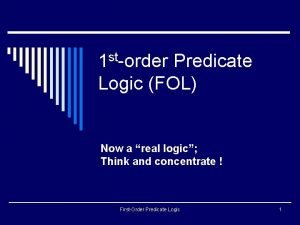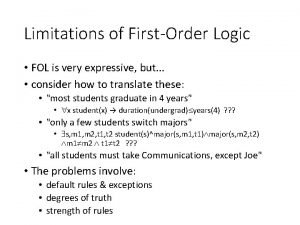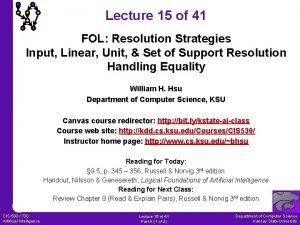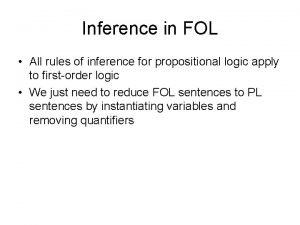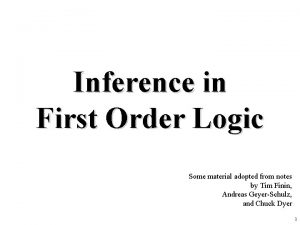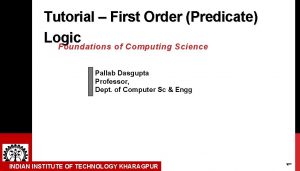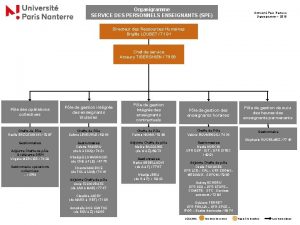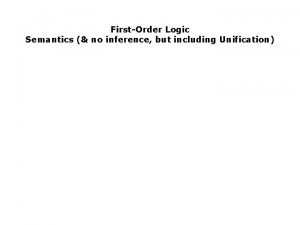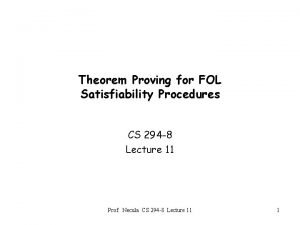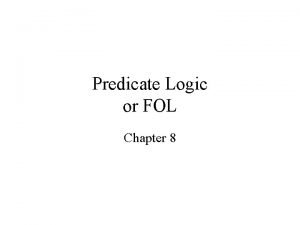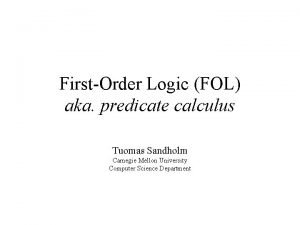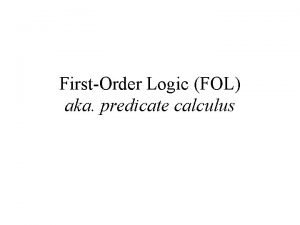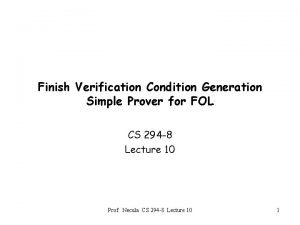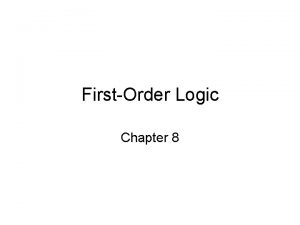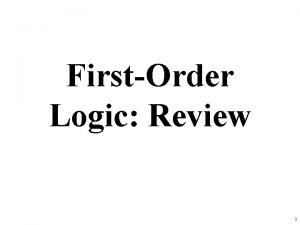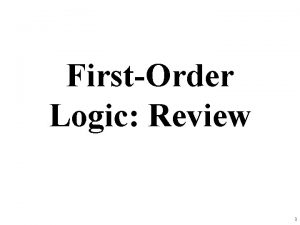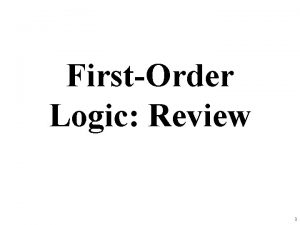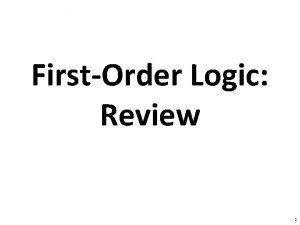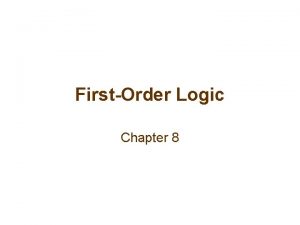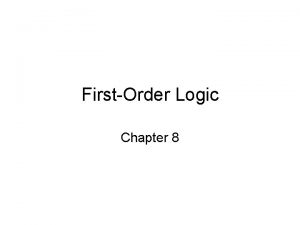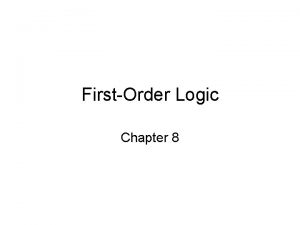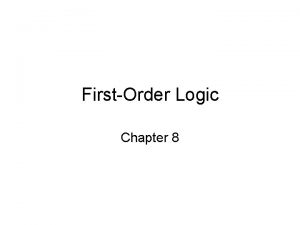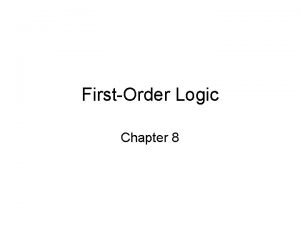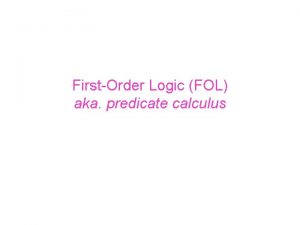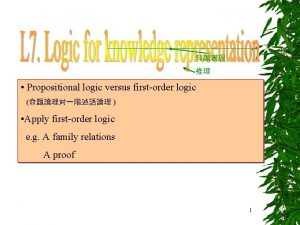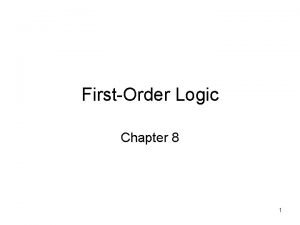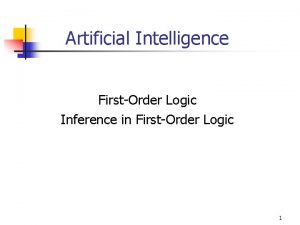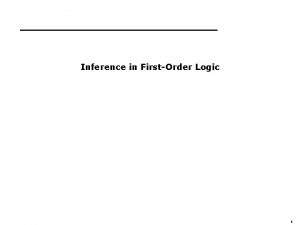FirstOrder Logic Chapter 8 Outline Why FOL Syntax


















![Deducing hidden properties • x, y, a, b Adjacent([x, y], [a, b]) [a, b] Deducing hidden properties • x, y, a, b Adjacent([x, y], [a, b]) [a, b]](https://slidetodoc.com/presentation_image/d23d2b69c04a041ea26465071a48901a/image-19.jpg)


- Slides: 21

First-Order Logic Chapter 8

Outline • • • Why FOL? Syntax and semantics of FOL Using FOL Wumpus world in FOL Knowledge engineering in FOL

Pros and cons of propositional logic Propositional logic is declarative Propositional logic allows partial/disjunctive/negated information – (unlike most data structures and databases) Propositional logic is compositional: – meaning of B 1, 1 P 1, 2 is derived from meaning of B 1, 1 and of P 1, 2 Meaning in propositional logic is context-independent – (unlike natural language, where meaning depends on context) Propositional logic has very limited expressive power – (unlike natural language) – E. g. , cannot say "pits cause breezes in adjacent squares“ • except by writing one sentence for each square

First-order logic • Whereas propositional logic assumes the world contains facts, • first-order logic (like natural language) assumes the world contains – Objects: people, houses, numbers, colors, baseball games, wars, … – Relations: red, round, prime, brother of, bigger than, part of, comes between, … – Functions: father of, best friend, one more than, plus, …

Syntax of FOL: Basic elements • The Universe of Discourse – Constants King. John, 2, NUS, . . . – Predicates Brother, >, . . . – Functions Sqrt, Left. Leg. Of, . . . • • Variables Connectives Equality Quantifiers x, y, a, b, . . . , , = ,

Atomic sentences Atomic sentence = predicate (term 1, . . . , termn) or term 1 = term 2 Term = function (term 1, . . . , termn) or constant or variable • E. g. , Brother(King. John, Richard. The. Lionheart) • > (Length(Left. Leg. Of(Richard)), Length(Left. Leg. Of(King. John)))

Complex sentences • Complex sentences are made from atomic sentences using connectives S, S 1 S 2, E. g. Sibling(King. John, Richard) Sibling(Richard, King. John) >(1, 2) ≤ (1, 2) >(1, 2)

Truth in first-order logic • Sentences are true with respect to a model and an interpretation • Model contains objects (domain elements) and relations among them • Interpretation specifies referents for constant symbols → objects predicate symbols → relations function symbols → functional relations • An atomic sentence predicate(term 1, . . . , termn) is true iff the objects referred to by term 1, . . . , termn are in the relation referred to by predicate

Models for FOL: Example Relations Brother(Richard, John) Left. Leg(John) On. Head(Crown, John)

Universal quantification • <variables> <sentence> ; Reads FOR ALL Everyone at UAA is smart: x At(x, UAA) Smart(x) • x P is true in a model m iff P is true with x being each possible object in the model • Roughly speaking, equivalent to the conjunction of instantiations of P . . . At(King. John, UAA) Smart(King. John) At(Richard, UAA) Smart(Richard) At(UAA, UAA) Smart(UAA)

A common mistake to avoid • Typically, is the main connective with • Common mistake: using as the main connective with : x At(x, UAA) Smart(x) means “Everyone is at UAA and everyone is smart”

Existential quantification • <variables> <sentence> reads THERE EXISTS • Someone at UAA is smart: • x At(x, UAA) Smart(x) • x P is true in a model m iff P is true with x being some possible object in the model • Roughly speaking, equivalent to the disjunction of instantiations of P At(King. John, UAA) Smart(King. John) At(Richard, UAA) Smart(Richard) At(UAA, UAA) Smart(UAA) . . .

Another common mistake to avoid • Typically, is the main connective with • Common mistake: using as the main connective with : x At(x, UAA) Smart(x) is true if there is anyone who is not at UAA!

Properties of quantifiers • • x y is the same as y x x y is not the same as y x x y Loves(x, y) – “There is a person who loves everyone in the world” • y x Loves(x, y) – “Everyone in the world is loved by at least one person” • Quantifier duality: each can be expressed using the other • x Likes(x, Ice. Cream) • x Likes(x, Broccoli)

Equality • term 1 = term 2 is true under a given interpretation if and only if term 1 and term 2 refer to the same object • E. g. , definition of Sibling in terms of Parent: x, y Sibling(x, y) [ (x = y) m, f (m = f) Parent(m, x) Parent(f, x) Parent(m, y) Parent(f, y)]

Using FOL The kinship domain: • Brothers are siblings x, y Brother(x, y) Sibling(x, y) • One's mother is one's female parent m, c Mother(c) = m (Female(m) Parent(m, c)) • “Sibling” is symmetric x, y Sibling(x, y) Sibling(y, x)

Interacting with FOL KBs • Suppose a wumpus-world agent is using an FOL KB and perceives a smell and a breeze (but no glitter) at t=5: Tell(KB, Percept([Smell, Breeze, None], 5)) Ask(KB, a Best. Action(a, 5)) • I. e. , does the KB entail some best action at t=5? • Answer: Yes, {a/Shoot} • • Given a sentence S and a substitution σ, Sσ denotes the result of plugging σ into S; e. g. , ← substitution (binding list) S = Smarter(x, y) σ = {x/Hillary, y/Bill} Sσ = Smarter(Hillary, Bill) • Ask(KB, S) returns some/all σ such that KB╞ σ

Knowledge base for the wumpus world • Perception – t, s, b Percept([s, b, Glitter], t) Glitter(t) • Reflex – t Glitter(t) Best. Action(Grab, t)
![Deducing hidden properties x y a b Adjacentx y a b a b Deducing hidden properties • x, y, a, b Adjacent([x, y], [a, b]) [a, b]](https://slidetodoc.com/presentation_image/d23d2b69c04a041ea26465071a48901a/image-19.jpg)
Deducing hidden properties • x, y, a, b Adjacent([x, y], [a, b]) [a, b] {[x+1, y], [x-1, y], [x, y+1], [x, y-1]} Properties of squares: • s, t At(Agent, s, t) Breeze(t) Breezy(s) Squares are breezy near a pit: – Diagnostic rule---infer cause from effect s Breezy(s) r Adjacent(r, s) Pit(r) – Causal rule---infer effect from cause r Pit(r) [ s Adjacent(r, s) Breezy(s) ]

Knowledge engineering in FOL 1. Identify the task 1. Assemble the relevant knowledge 1. Decide on a vocabulary of predicates, functions, and constants 1. Encode general knowledge about the domain 1. Encode a description of the specific problem instance 1. Pose queries to the inference procedure and get answers 1. Debug the knowledge base

Summary • First-order logic: – objects and relations are semantic primitives – syntax: constants, functions, predicates, equality, quantifiers • Increased expressive power: sufficient to define wumpus world
 Hey bye bye
Hey bye bye Syntax of mkleaf is
Syntax of mkleaf is Fol is a
Fol is a Fol in ai
Fol in ai Resolution in fol
Resolution in fol Resolution in fol
Resolution in fol Resolution in fol
Resolution in fol Resolution in fol
Resolution in fol Predicate logic tutorial
Predicate logic tutorial Spe nanterre
Spe nanterre First order logic unification
First order logic unification Cs fol
Cs fol Fol eol
Fol eol Conjuctive normal form concentrates on eliminating
Conjuctive normal form concentrates on eliminating Fol
Fol Modus ponens example
Modus ponens example Fol
Fol Femelle 20 cd componentes
Femelle 20 cd componentes First order logic syntax
First order logic syntax Syntax of first order logic
Syntax of first order logic First order logic vs propositional logic
First order logic vs propositional logic First order logic vs propositional logic
First order logic vs propositional logic


